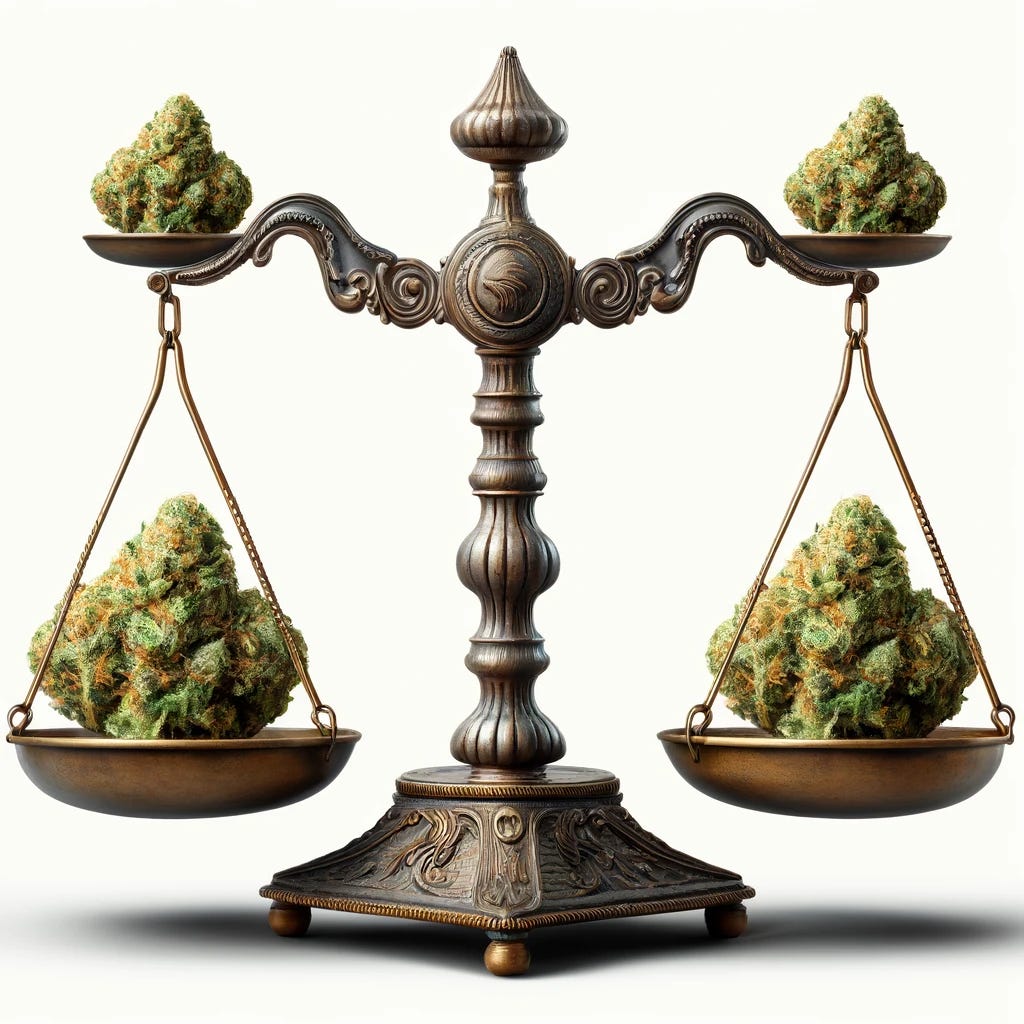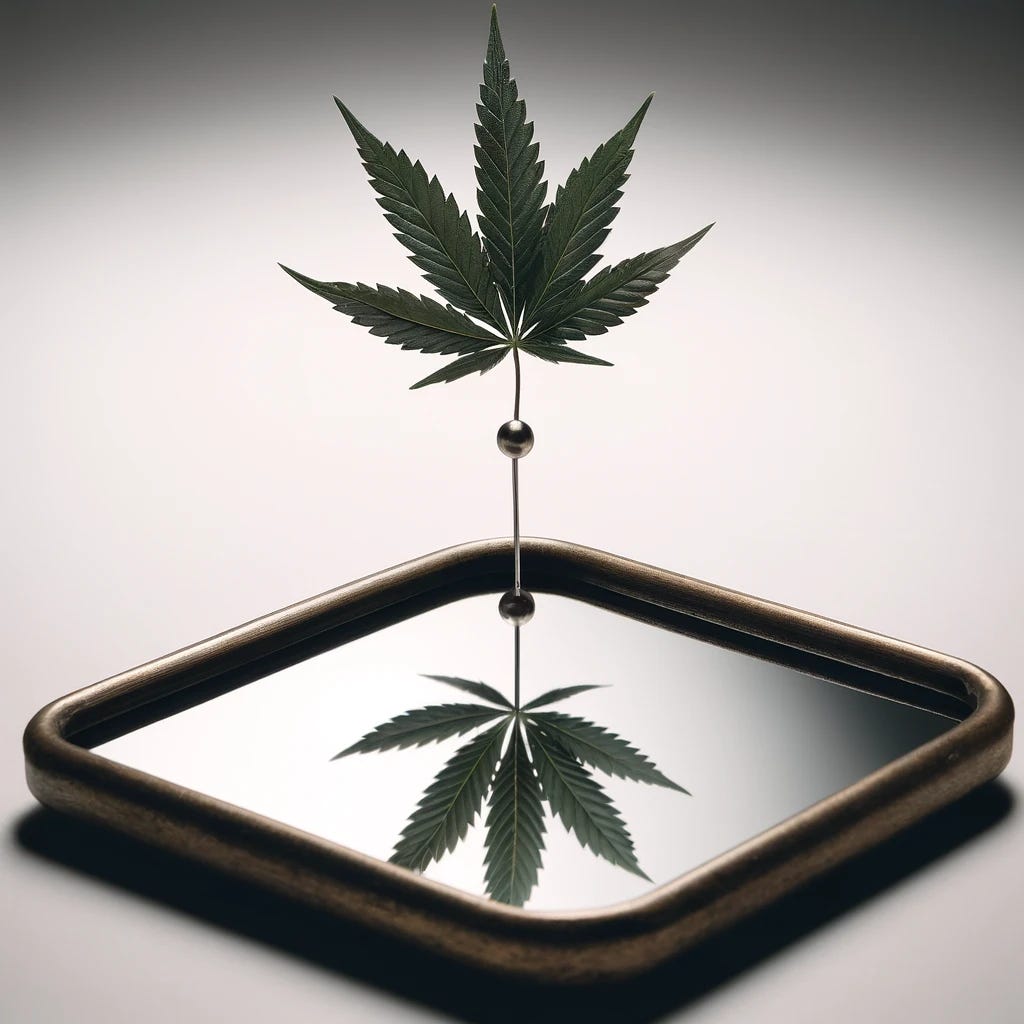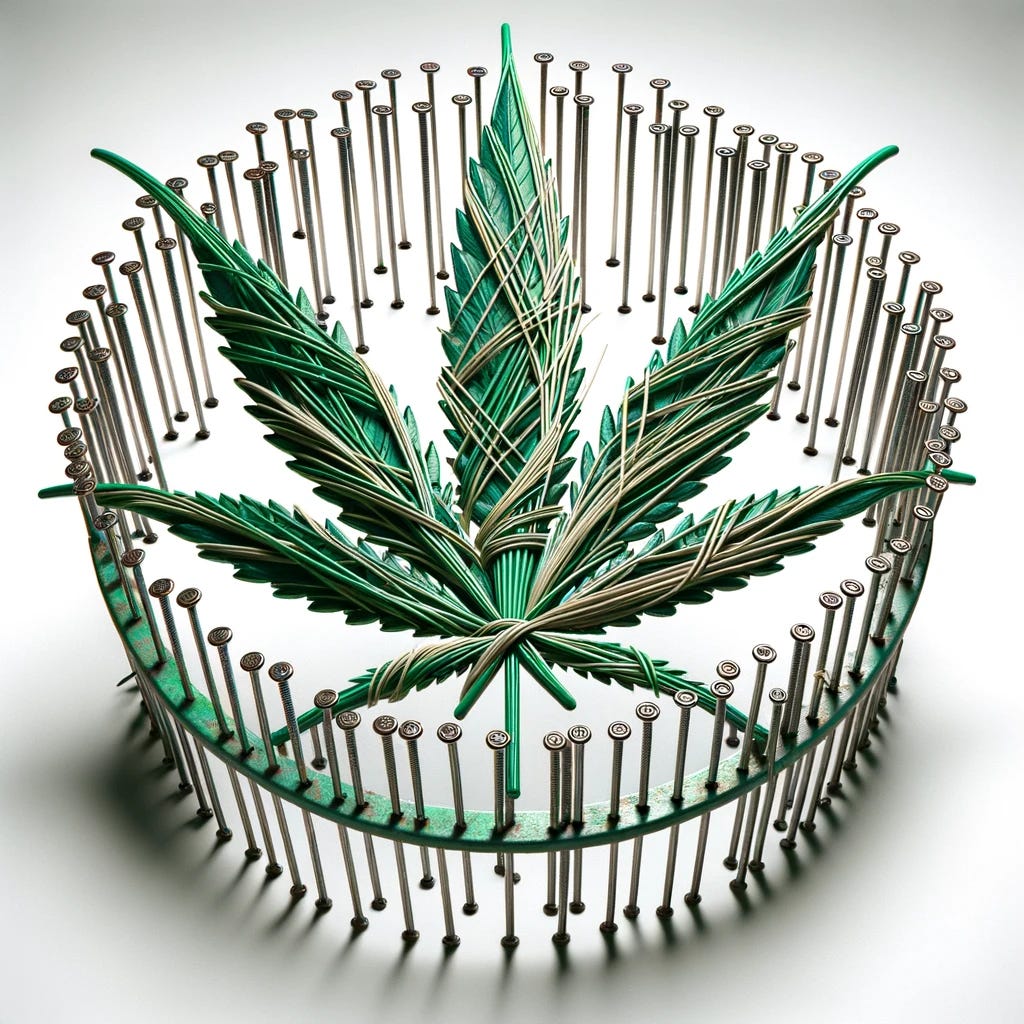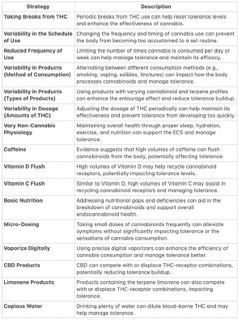Cannabis Tolerance Demystified: 1/12
Explaining the Science and Practical Tools for Navigation
Welcome to my series on understanding cannabis tolerance.
Cannabis tolerance is one of the most common downsides of cannabis consumption. Tolerance is a fascinating and seemingly simple issue: a dosage that worked before no longer does. But, this simple manifestation represents a complex phenomenon that affects both new and experienced users. Whether you call your use of cannabis “medical” or “recreational”, understanding how tolerance develops, its underlying mechanisms, and how to manage it effectively is helpful to optimizing your cannabis experience, and certainly helps to keep costs in control.
In this series, I'll explore various aspects of cannabis tolerance, including the roles of different cannabinoids and terpenes, the impact of various consumption methods, and differences that we see between medical and “adult-use” use. I'll also cover practical strategies to manage tolerance, the potential risks associated with high tolerance, and the variability among individuals. And, to keep everyone on their toes, I’ll also share the radical idea that tolerance may even have some benefits.
Recently, the scientific literature on nutrition has taught us that a diet rich in vegetables and fruits helps to prevent aspects of cancer growth, through a phenomenon called “anti-angiogenesis” (the inhibition of new blood vessel formation.) As you consume more vegetation, the normal balance that the body holds, between too much blood vessel production and too little is tipped away from the production of “too many” new blood vessels. Cannabis = vegetation.
This comprehensive series aims to empower you with the knowledge you need to make informed decisions about your cannabis use, maintain the effectiveness of your products, and enhance your overall well-being.
A look ahead at this series:
Cannabinoid Profiles and Their Effects
Understanding the Role of Minor Cannabinoids in Cannabis
How Cannabinoid Profiles Impact Tolerance
Practical Applications
(see below! 👇 )
Impact of Terpenes on Cannabis Effects
How Terpenes Influence Cannabis Effects and Tolerance
Key Terpenes and Their Effects
Practical Applications
Tolerance Under Different Consumption Methods
How Different Methods Affect Cannabis Tolerance
Smoking, Vaping, Edibles, Tinctures, and Transdermal Patches
Practical Applications
Medical vs. Recreational Cannabis Use
Differences in Tolerance Development and Consumption Patterns
Practical Applications
Potential Risks and Side Effects of Cannabis Tolerance
Understanding the Long-Term Health Implications
Managing the Risks
Variability in Cannabis Tolerance Among Individuals
Why Some People Develop Tolerance Faster Than Others
Practical Applications
Strategies to Mitigate Cannabis Tolerance
Effective Strategies to Maintain Effectiveness and Manage Dosages
Practical Applications
Detailed Mechanisms of Cannabis Tolerance
How Tolerance Develops and Affects Cannabis Use
Practical Applications
Unique Cases of Cannabis Tolerance
Why Some Individuals Develop Tolerance Differently
Practical Applications
Lifestyle Factors Impacting Cannabis Tolerance
How Diet, Exercise, and Sleep Affect Tolerance
Practical Applications
Combining Cannabis with Other Substances
Understanding Cross-Tolerance and Interaction Effects
Practical Applications
Legal and Regulatory Considerations
How Legalization Affects Consumption Patterns and Tolerance
Practical Applications
This series was inspired by a subscriber’s question - please share your comments!
… If your comment or question is selected for an answer, you'll receive a free month of paid access as a thank you!
Cannabinoid Profiles and Their Effects
Understanding the Role of Minor Cannabinoids in Cannabis
How Cannabinoid Profiles Impact Tolerance
Practical Applications
Effects of Cannabinoids on Tolerance
Defining Terms: Understanding Tolerance
Tolerance is when you need more of something over time to get the same effect. For many, it's about needing a larger dose of cannabis to sleep better when a 5mg gummy just isn't cutting it anymore, to unwind properly after a long day, or to feel the same pleasurable effects that used to come with a smaller dose. For others, it's more specific: like a Parkinson's patient who starts feeling stiffer again after using the same dose for a while, someone with Myasthenia Gravis whose eyelids start drooping earlier in the day despite their regular oil dose, or a child with autism who can't settle down at home because the edibles aren't working as well as they used to. Understanding tolerance is key to managing your cannabis use effectively and ensuring you continue to get the benefits you need.
This series will explore many different components of tolerance. While it may seem like TMI to those who think their struggle with tolerance is due to just one factor needing a tweak, the reality is that each aspect of tolerance I'll review affects everyone in one way or another—or likely will one day!
Exploring the Secrets of Minor Cannabinoids
Understanding the diverse profiles of cannabinoids in natural cannabis products is crucial for grasping their effects and how they influence tolerance development. In this discussion, I’ll focus on both natural products (derived directly from the plant) and Marijuana-Infused Products (MIPs), which incorporate cannabis into items like edibles, drinks, or lotions. Interestingly, people can develop tolerance to any of these products. However, some individuals are lucky enough never to develop tolerance at all.
It's also important to note that the more homogeneous or fewer the ingredients in a product, the more likely it is to cause tolerance. For example, a 5mg "pure THC" gummy is more likely to lead to tolerance sooner than a 5mg "THC+CBD" gummy or a 5mg THC gummy that's lemon-flavored.
Cannabinoid profiles refer to the unique combination of cannabinoids in a product, including THC, CBD, and minor cannabinoids like CBG, CBC, or CBN. These compounds interact with the body’s endocannabinoid system, influencing overall effects and potentially impacting the development of tolerance.
In many cases, product manufacturers produce edible products with delicious or curious flavors- mango, watermelon, cinnamon, wild berry, etc. While these flavors are usually chosen to help offset what is a naturally bitter taste to cannabinoids, it just so happens that these "flavors” work on some of the same receptors as the cannabinoids, and actually help to offset tolerance build up. So, long-story short, mixing up flavors can actually help offset tolerance too. But, more on that later.
Understanding the Role of Minor Cannabinoids in Cannabis
Different cannabinoids interact uniquely with the endocannabinoid system. THC (tetrahydrocannabinol) is well-known as the psychoactive star, binding to CB1 receptors in the brain and mimicking the natural cell-signaling molecule anandamide. Unlike hormones, which are stored and released by the endocrine system, anandamide acts in a paracrine (affecting nearby cells) or autocrine (affecting the same cell) manner. Both hormones and endocannabinoids are cell-signaling molecules, but they differ in how they are produced, transported, stored, and their target effects.
Repeated exposure to THC, however, is what leads to tolerance. Over time, CB1 receptors become less responsive and fewer in number, reducing THC's effectiveness.
CBD (cannabidiol) does not bind directly to CB1 receptors but does modulates their activity. If you think of the receptor systems as a giant stereo, CBD molecules might be acting as audio controls or sound settings (adjusting the parameters like bass, treble, balance, etc) while THC might be thought of as a different aspect of the sound produced. CBD also interacts with other receptors, like the serotonin receptor (5-HT1A) and the TRPV1 ion channel, which appear to be involved in counteractacting some of the tolerance-building effects of THC. This means that products with a balanced cannabinoid profile, including both THC and CBD, typically lead to slower tolerance development compared to THC-dominant products.
People mistakenly refer to CBD as “non-psychoactive.” This usually stems from a different interpretation of the word. If we think of psycho-activity as euphoria, CBD is typically not euphoric, but for some people it actually does cause some pleasant alternations. If we think of psycho-activity as just changes in perception, if CBD causes some degree of relaxation (whether muscular or mentally calming if not euphoric per se, can’t we still label that as impacting one’s consciousness in the same way that, a cold splash of water on the face would be calming on a hot summer’s day?
The Role of Minor Cannabinoids
Minor cannabinoids like CBG (cannabigerol) and CBN (cannabinol) also play significant roles in the overall effects of cannabis when it is consumed into the body.
CBG: Non-euphoric, it and can influence various receptors, including CB1 and CB2, enhancing the effects of THC without directly causing tolerance through CB1 receptor binding. Going along with the stereo analogy, these function perhaps like the treble, or the balance, or some other audio-equalizer function. Not quite like volume, but certainly related.
CBN: A mildly euphoric cannabinoid and degradation product of THC, it binds to CB2 receptors, providing complementary effects without significantly contributing to CB1 receptor tolerance.
How Cannabinoid Profiles Impact Tolerance
The point to pull away from the letter salad here, is that cannabinoid profiles can and DO significantly impact how quickly tolerance develops and how effectively it can be managed. For example:
Balanced Profiles: Products that contain both THC and CBD can help slow down the development of tolerance. Why? Because CBD modulates CB1 receptor activity and can counteract some of the desensitization effects caused by THC.
Entourage Effect: The presence of minor cannabinoids like CBG, CBN, and CBC, along with terpenes, can create a synergistic effect that will enhance the therapeutic benefits of other cannabinoids and may reduce the need for higher doses of THC, hence another explanation for slowing the development of tolerance.
Full-Spectrum Products: Finding and consuming so-called “full-spectrum” products (those that have a wide variety of ingredients) that contain a variety of cannabinoids and terpenes can provide a more balanced experience and may prevent the rapid onset of tolerance that is often seen with THC-only products.
Practical Applications
Understanding the cannabinoid profiles in your cannabis products can help you make more informed choices. Here are some practical applications:
Product Selection: Choose products that offer a balanced profile of THC and CBD (and/or other cannabinoids and terpenes) to push against the development of tolerance.
Full-Spectrum Products: When the choice arrives, opt for full-spectrum products to take advantage of the synergistic effect the industry lovingly calls the entourage effect, which may help maintain therapeutic benefits without escalating doses.
Monitoring and Adjusting: Regularly monitor your response to cannabis and adjust your product choice and dosage as needed to manage tolerance effectively. Another way of saying: don’t be afraid of tolerance. Even if it happens, provided the prices aren’t prohibitively high, there are some added benefits you get from taking larger doses of products - more on that later.
Table: Examples of Minor Cannabinoids and Their Effects
The Entourage Effect
The entourage effect refers to the synergistic interaction between cannabinoids and terpenes that enhances the therapeutic benefits of cannabis. This concept suggests that the combined effects of various cannabinoids and terpenes can be more beneficial and potentially less likely to lead to tolerance than isolated THC.
Practical Applications of Cannabinoid Synergistic Power
Enhanced Therapeutic Benefits: Enhanced Therapeutic Benefits: Using full-spectrum products that contain a variety of cannabinoids and terpenes can provide a more comprehensive therapeutic effect than a product with just one ingredient, not just because of the impact the non-THC molecules have on THC, but because of the action these non-THC molecules have in their own right, potentially reducing the need for higher doses of THC and slowing tolerance development. It's like a well-orchestrated symphony, where each instrument contributes to a richer, more harmonious sound, compared to a solo performance that relies on a single instrument.
Balanced Effects: By combining cannabinoids like THC, CBD, and minor cannabinoids with terpenes, users can achieve a more balanced and effective experience. This approach helps manage tolerance because it allows users to benefit from the unique properties of non-THC compounds, making the body more receptive to a broader range of therapeutic effects. It's like a well-rounded diet; instead of relying solely on one type of food, incorporating a variety of nutrients ensures better overall health and satisfaction.
Product Choice: Product Choice: Look for products labeled as broad-spectrum or full-spectrum, or those that list their cannabinoid and terpene profiles. Alternatively, consider combining two different products at the same time to mix in the belly. This approach allows you to take full advantage of the entourage effect, where the combined action of multiple compounds enhances the overall therapeutic benefits. To carry on the food analogy, considering product choice is like putting together a gourmet meal; using a variety of high-quality ingredients together results in a richer and more satisfying experience than any single ingredient alone..
Take Away:
By understanding how different cannabinoids interact, you can get the most out of your cannabis use, boosting therapeutic benefits while keeping tolerance in check. This deeper knowledge of cannabinoid profiles helps you tailor your experience for more personalized and lasting, effective results.
Links to More:
Internal: Review of Cannabis and Lung Health
External: A CED Clinic Blog about Tolerance
Next Monday: Part 2/12
Impact of Terpenes on Cannabis Effects
How Terpenes Influence Cannabis Effects and Tolerance
Key Terpenes and Their Effects
Practical Applications
BC: Got thoughts on this series or a story of your own? I’d love to hear it - and share it!
Your insights matter - comment below or share anonymously. Together, we can create a community of awareness and heartfelt experiences.
For paid subscribers: Below is The Tolerance List, a take-home cheat sheet table of 16 practical ways to reduce your tolerance, derived from this YouTube talk from a few years ago.
Keep reading with a 7-day free trial
Subscribe to Doctor Approved to keep reading this post and get 7 days of free access to the full post archives.














